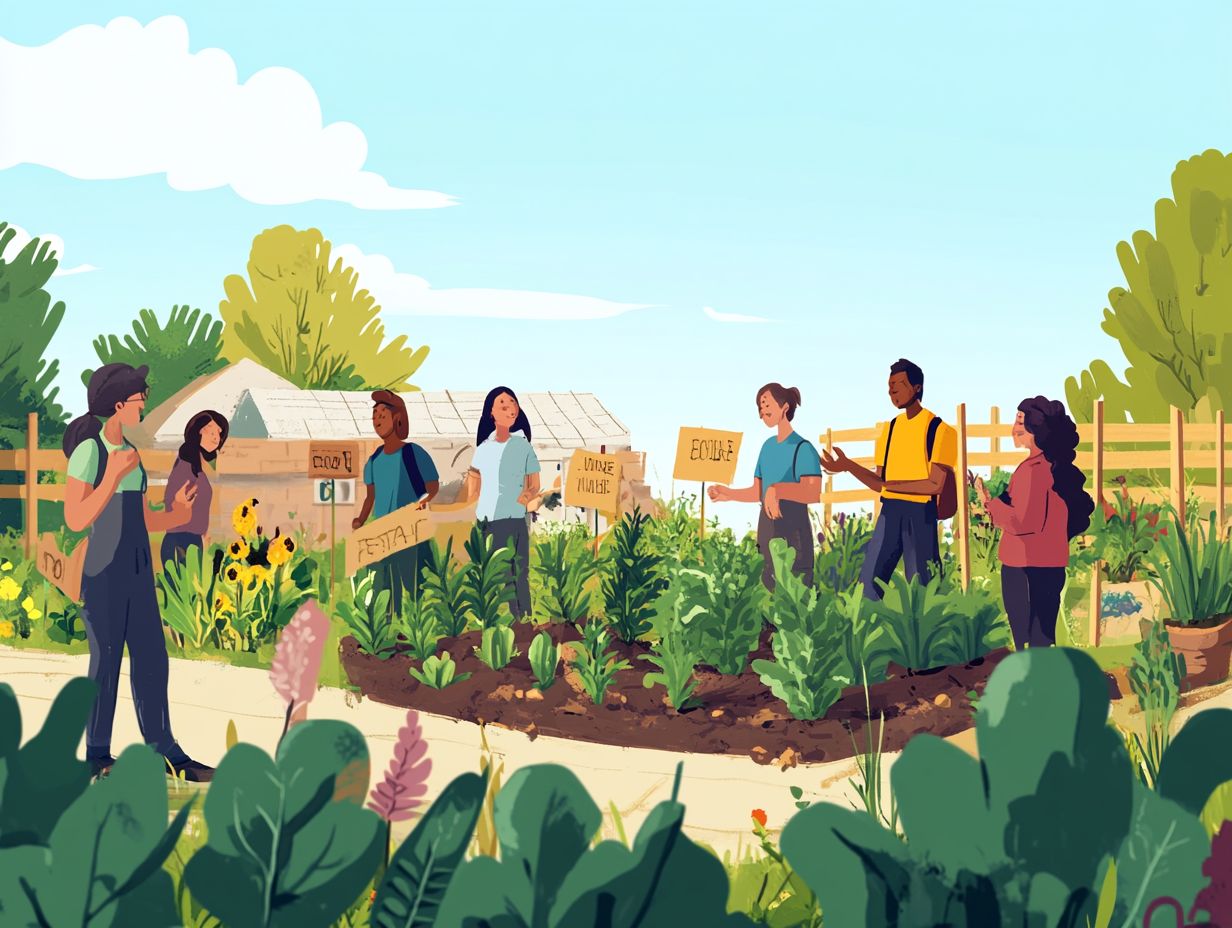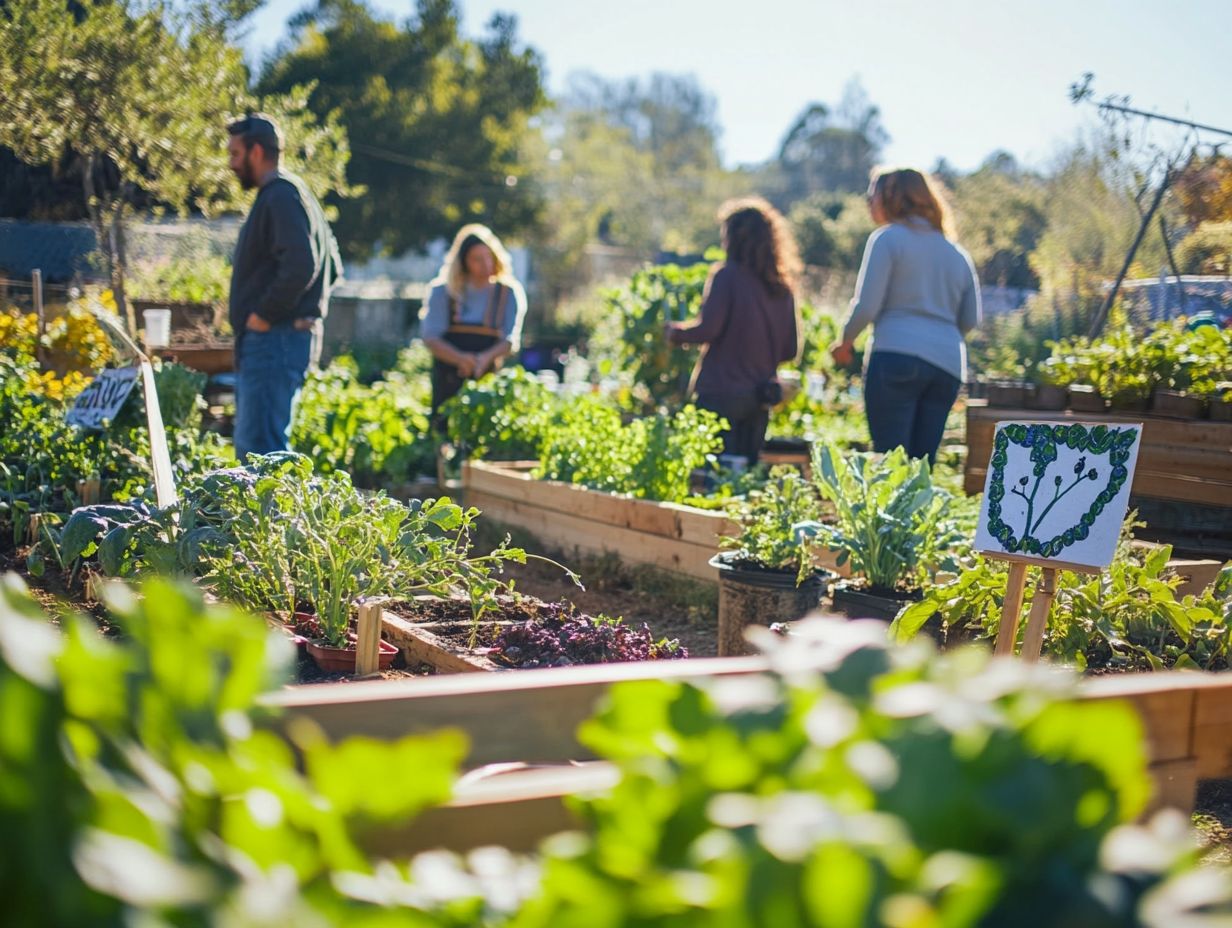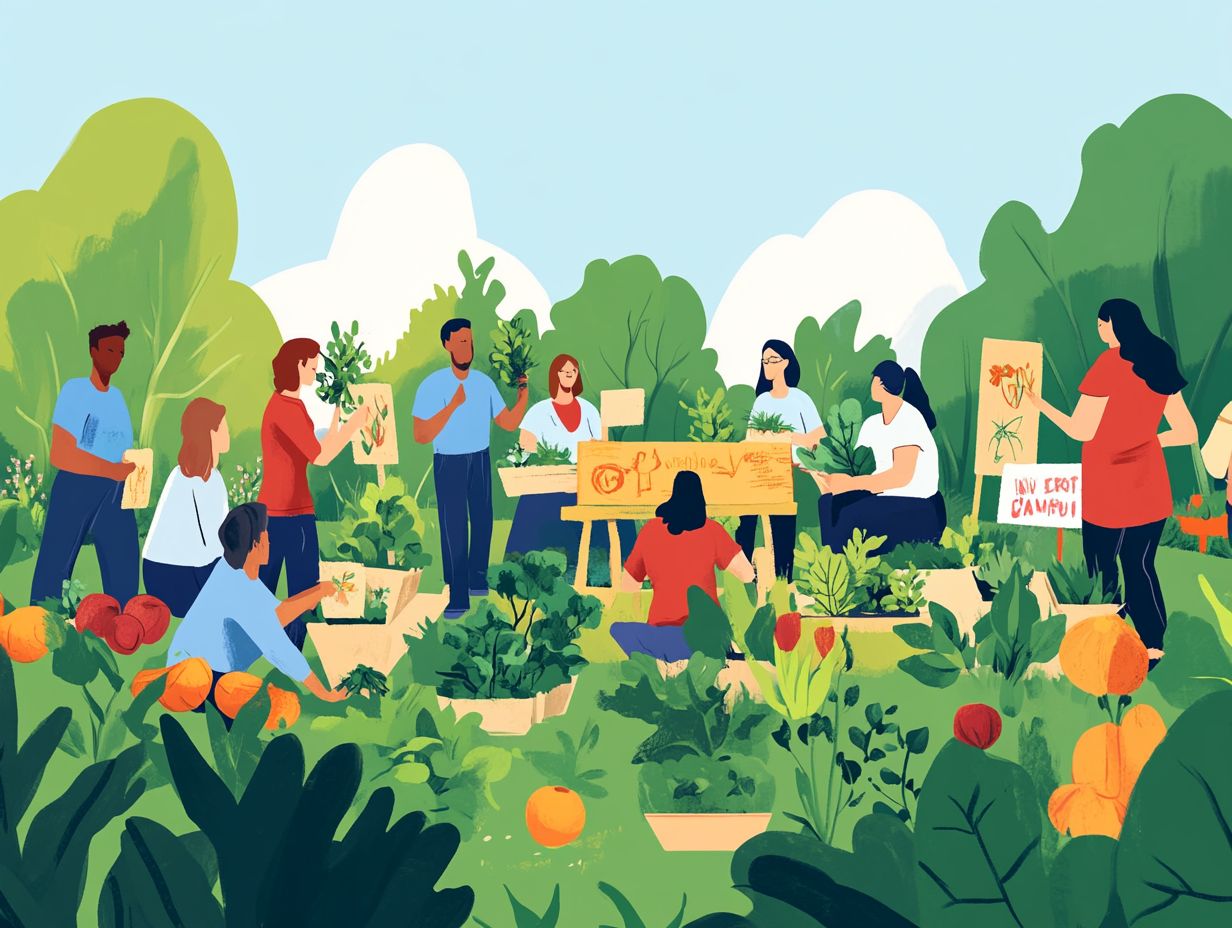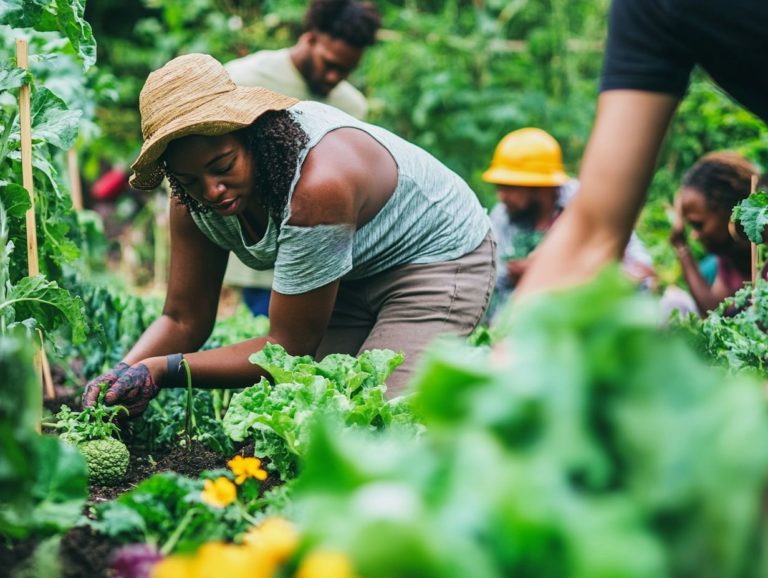71. 5 Challenges Facing Permaculture Communities Today
Permaculture communities are emerging as a promising solution to the pressing environmental and agricultural challenges of today. However, they encounter significant hurdles along the way.
You may find that these communities grapple with limited access to land and face bureaucratic obstacles, such as zoning permits. They also struggle with a lack of funding and educational resources. This combination can make it difficult for them to truly thrive.
Traditional agricultural systems often resist the innovative practices that permaculture promotes.
Get ready to dive into the challenges and discover how to overcome them! This article sheds light on how these challenges can be navigated and the substantial benefits that successful permaculture communities can contribute to sustainability efforts.
Together, you’ll uncover the key principles of permaculture, explore inspiring success stories, and discuss the crucial role that government and policymakers play in nurturing these transformative communities.
Contents
- Key Takeaways:
- 1. Lack of Access to Land
- 2. Difficulty in Obtaining Permits and Zoning
- 3. Limited Resources and Funding
- 4. Lack of Education and Awareness
- 5. Resistance from Traditional Agricultural Systems
- How Can These Challenges Be Overcome?
- Frequently Asked Questions
- What is permaculture and why is it important?
- What are the main challenges facing permaculture communities today?
- How does access to land affect permaculture communities?
- Why is lack of government support a challenge for permaculture communities?
- How does climate change impact permaculture communities?
- What can be done to address cultural barriers in permaculture communities?
Key Takeaways:

- Access to land is a major challenge facing permaculture communities, hindering their ability to create sustainable practices.
- Obtaining permits and zoning for permaculture projects can be difficult, as traditional agricultural systems are often prioritized.
- Limited resources and funding can also make it challenging for permaculture communities to thrive and grow.
1. Lack of Access to Land
The lack of access to land presents a formidable challenge for global consumers and communities aspiring to achieve meaningful sustainable transformation. This limitation stifles the development of sustainable products and practices that are vital for fostering environmental sustainability and bolstering community resilience in the face of climate change.
When communities find it difficult to secure land, their capacity to engage in farming methods that restore the land diminishes. This directly impacts their credibility and effectiveness in making sustainability claims. Consequently, this scenario can lead to consumer skepticism, influencing purchasing decisions as individuals actively seek out authentic eco-friendly options.
Take, for instance, brands that have successfully tackled land access issues, such as community-supported agriculture (CSA) programs. These enable local farmers to sell directly to consumers and foster trust and transparency.
Innovative market strategies, like land-sharing initiatives or cooperative farming models, create pathways for marginalized groups to gain access. This promotes inclusive practices that can enhance trust in sustainability claims.
2. Difficulty in Obtaining Permits and Zoning
Obtaining permits and zoning approvals can pose a significant barrier to your sustainable purchasing and development efforts. This complicates the implementation of innovative market strategies aimed at promoting environmental sustainability.
These regulatory hurdles often breed uncertainty, deterring both businesses and consumers from investing in sustainable options. For instance, the lengthy approval processes for green building projects might lead you to abandon promising ideas, fearing the financial repercussions of delays. This reluctance not only stifles innovation but also reinforces consumer skepticism about the effectiveness of sustainable practices.
However, there are inspiring examples that challenge this narrative. Take Portland, Oregon, for instance, where collaborative efforts have successfully streamlined permitting processes. As a result, local communities have embraced eco-friendly businesses and urban gardens, transforming consumer attitudes toward sustainability from mere interest to active participation.
Join the movement and support local eco-friendly initiatives in your community!
3. Limited Resources and Funding
Limited resources and funding pose a significant challenge for those invested in sustainability. This often results in constrained consumer preferences and a steep price tag for sustainable options.
This financial burden stifles innovation for eco-friendly products. It also limits initiatives that encourage greener consumer behaviors. Social design is a vital solution that bridges this gap by facilitating the creation of affordable, sustainable products that appeal to a wider audience.
By emphasizing user-centered solutions that blend functionality with aesthetic appeal, social design enables you to make purchasing decisions that reflect your environmental values. This approach fosters a culture of sustainability that can thrive, even in the face of financial limitations.
4. Lack of Education and Awareness

A lack of education and awareness about sustainability practices significantly shapes your consumer behavior. This often leads to misguided purchasing decisions that can undermine community resilience and feed into greenwashing, which refers to misleading claims about a company’s environmental practices.
To effectively tackle this issue, it’s essential for educational initiatives to cultivate a deeper understanding of sustainable practices. By highlighting the long-term benefits of eco-friendly products and debunking common myths surrounding them, you can make informed choices that truly align with your values.
Utilizing strategic communication methods, such as engaging storytelling and compelling visual aids, can resonate with you and simplify complex concepts. This approach not only encourages responsible consumption but also enables you to challenge misleading marketing claims. Ultimately, it fosters a more informed society dedicated to creating a positive environmental impact.
5. Resistance from Traditional Agricultural Systems
Resistance from traditional agricultural systems presents significant challenges in implementing sustainability initiatives. You ll find that entrenched consumer attitudes often lean toward established practices, sidelining innovative sustainable farming methods that work with nature.
This friction complicates the integration of newer, environmentally-friendly approaches and reveals a broader societal reluctance to embrace change. As you engage with practices like crop rotation and agroforestry, you may encounter skepticism from consumers who remain loyal to conventional farming methods, impacting market demand.
However, successful permaculture communities in Australia and the United States illustrate that educating consumers about the ecological and economic benefits of sustainable agriculture can effectively shift perspectives. By emphasizing tangible advantages such as improved soil health and reduced pesticide use these communities cultivate a mindset that prioritizes long-term health over short-term gains, ultimately paving the way for a new agricultural paradigm.
How Can These Challenges Be Overcome?
Overcoming the challenges of achieving sustainability requires you to seek innovative solutions that tackle barriers to sustainable purchasing. This will enhance community resilience while aligning with the preferences of global consumers.
As a market leader, you have a pivotal role in this transition. By leveraging your influence, you can introduce eco-friendly products and champion transparency in sourcing and production processes. Prioritizing consumer education allows you to effectively communicate the benefits of sustainable choices, ultimately shifting purchasing behaviors.
Implementing strategies such as incentivizing local sourcing, promoting eco-conscious brands, and establishing robust recycling programs can significantly enhance community engagement. Involving local stakeholders in decision-making fosters a sense of ownership and responsibility, cultivating a sustainable marketplace that resonates with the evolving preferences of environmentally-minded consumers.
Act now to transform your community!
What Are the Benefits of Permaculture Communities?
Permaculture communities present a wealth of benefits, such as reducing environmental impact, transforming neighborhoods, and shifting consumer behavior toward sustainable practices.
These advantages reach well beyond individual households, enriching soil health through regenerative agricultural methods that enhance fertility and variety of plants and animals. Instead of leaning on synthetic fertilizers, these communities champion composting and crop rotation, allowing ecosystems to thrive in their natural state.
You ll notice a significant reduction in resource consumption as locals embrace rainwater harvesting, effectively minimizing water waste and decreasing their carbon footprints.
Inspiring stories from various regions illustrate how permaculture initiatives have revitalized local economies, creating job opportunities in sustainable farming and craft trades while strengthening community bonds through cooperative efforts.
Take, for example, a small town that adopted these principles it not only bolstered its food security but also fostered stronger neighborly ties. Join your neighbors in shared gardening activities! This approach ultimately transformed a once-fragmented community into a resilient hub of social and ecological harmony.
How Can Permaculture Communities Promote Sustainability?

Permaculture communities champion sustainability by embracing principles that cultivate a healthy relationship between living things and their environment and strengthen community resilience through education and active participation.
These initiatives invite you to deepen your understanding of the environment, enabling you to make informed choices about resource use and waste management. Community gardens function as vibrant classrooms where you and your neighbors learn the art of companionship through the processes of planting, maintaining, and harvesting food organically.
Inspiring stories from various urban neighborhoods reveal remarkable shifts in consumer attitudes. People like you have transformed their shopping habits, increasingly gravitating towards local produce and supporting eco-friendly businesses. These examples showcase the effectiveness of permaculture practices and ignite creativity for broader societal changes, fostering a culture of sustainability that resonates throughout the community.
Act now to create a sustainable future!
What Are the Key Principles of Permaculture?
The key principles of permaculture center on sustainable practices designed to enhance your environmental impact, bolster community resilience, and weave social design into a fabric of sustainable living.
These principles guide you and your community to create systems that work in harmony with nature. For example, the principle of “Observe and Interact” encourages you to thoughtfully analyze your environment, providing insights into how natural processes operate. This understanding can guide you in making informed decisions about land use.
Another essential principle, “Catch and Store Energy,” highlights the importance of efficiently harvesting resources like sunlight and rainfall to maximize their benefits.
The principle of “Design from Patterns to Details” urges you to take a broader view before focusing on specifics, ensuring that your designs are seamlessly integrated into the surrounding ecosystem.
By embracing these principles, you can cultivate a more sustainable way of life that honors and nurtures the earth. Get involved with your local permaculture community today!
What Are Some Successful Permaculture Community Examples?
Successful examples of permaculture communities include Dancing Rabbit Ecovillage and Earthaven Ecovillage. These communities highlight the potential for transformation through sustainable practices and collaborative living.
These communities serve as inspiring models. They employ innovative techniques and are deeply committed to care for the environment.
The unique methods they adopt often integrate organic farming, water conservation, and renewable energy sources. This addresses immediate environmental challenges while fostering a sense of unity among members.
By examining the obstacles they faced such as resource limitations and community engagement you can glean valuable lessons in resilience. The beneficial outcomes they achieved, including boosted local biodiversity and enhanced food security, serve as a blueprint that you can replicate in other communities aiming for similar transformative effects.
What Role Can Government and Policy Makers Play in Supporting Permaculture Communities?
Government and policymakers play a vital role in supporting permaculture communities by tackling barriers to sustainable purchasing and enacting policies that bolster community resilience.
By proactively engaging with local stakeholders, you can identify challenges unique to your region, such as limited access to organic products or inadequate funding for eco-friendly initiatives.
These collaborative efforts not only enhance community trust in governmental actions but also foster partnerships that emphasize sustainable practices.
When communities see a genuine commitment to improving agricultural practices, it cultivates a sense of shared responsibility and empowerment. This ultimately leads to more effective sustainability initiatives and better outcomes for consumers.
Frequently Asked Questions

What is permaculture and why is it important?
Permaculture is about designing sustainable and self-sufficient communities based on natural ecosystems. It s crucial because it encourages environmental care and helps communities thrive.
What are the main challenges facing permaculture communities today?
The five main challenges include access to land, lack of government support, limited education and resources, climate change, and cultural barriers.
How does access to land affect permaculture communities?
Access to land is a major challenge as it can be expensive and difficult to secure, especially in urban areas. This limits the ability of communities to implement sustainable living practices, potentially leading to displacement.
Why is lack of government support a challenge for permaculture communities?
Many permaculture communities struggle with government support and policies. Zoning laws may restrict sustainable practices, and there can be a lack of funding for permaculture projects. Understanding common challenges in permaculture gardening highlights how, without this support, it can be difficult for these communities to thrive.
How does climate change impact permaculture communities?
Climate change poses a significant threat, disrupting natural ecosystems and making it difficult to grow certain crops. This can lead to water scarcity and extreme weather events, negatively impacting permaculture projects.
What can be done to address cultural barriers in permaculture communities?
Cultural barriers, such as resistance to change or misunderstanding of permaculture principles, can hinder growth. Education and outreach programs can raise awareness and promote inclusivity in permaculture practices, helping to develop community leadership in permaculture.
Are you ready to explore permaculture in your community? Start by learning more about local initiatives and getting involved!






